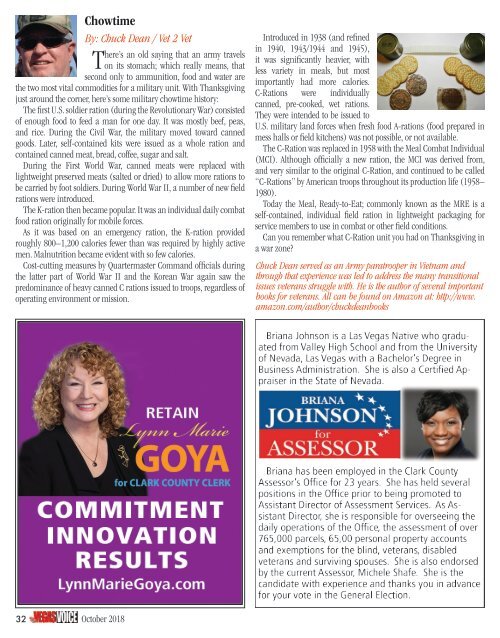Vegas Voice 10-18
You also want an ePaper? Increase the reach of your titles
YUMPU automatically turns print PDFs into web optimized ePapers that Google loves.
Chowtime<br />
By: Chuck Dean / Vet 2 Vet<br />
There’s an old saying that an army travels<br />
on its stomach; which really means, that<br />
second only to ammunition, food and water are<br />
the two most vital commodities for a military unit. With Thanksgiving<br />
just around the corner, here’s some military chowtime history:<br />
The first U.S. soldier ration (during the Revolutionary War) consisted<br />
of enough food to feed a man for one day. It was mostly beef, peas,<br />
and rice. During the Civil War, the military moved toward canned<br />
goods. Later, self-contained kits were issued as a whole ration and<br />
contained canned meat, bread, coffee, sugar and salt.<br />
During the First World War, canned meats were replaced with<br />
lightweight preserved meats (salted or dried) to allow more rations to<br />
be carried by foot soldiers. During World War II, a number of new field<br />
rations were introduced.<br />
The K-ration then became popular. It was an individual daily combat<br />
food ration originally for mobile forces.<br />
As it was based on an emergency ration, the K-ration provided<br />
roughly 800–1,200 calories fewer than was required by highly active<br />
men. Malnutrition became evident with so few calories.<br />
Cost-cutting measures by Quartermaster Command officials during<br />
the latter part of World War II and the Korean War again saw the<br />
predominance of heavy canned C rations issued to troops, regardless of<br />
operating environment or mission.<br />
Introduced in 1938 (and refined<br />
in 1940, 1943/1944 and 1945),<br />
it was significantly heavier, with<br />
less variety in meals, but most<br />
importantly had more calories.<br />
C-Rations were individually<br />
canned, pre-cooked, wet rations.<br />
They were intended to be issued to<br />
U.S. military land forces when fresh food A-rations (food prepared in<br />
mess halls or field kitchens) was not possible, or not available.<br />
The C-Ration was replaced in 1958 with the Meal Combat Individual<br />
(MCI). Although officially a new ration, the MCI was derived from,<br />
and very similar to the original C-Ration, and continued to be called<br />
“C-Rations” by American troops throughout its production life (1958–<br />
1980).<br />
Today the Meal, Ready-to-Eat; commonly known as the MRE is a<br />
self-contained, individual field ration in lightweight packaging for<br />
service members to use in combat or other field conditions.<br />
Can you remember what C-Ration unit you had on Thanksgiving in<br />
a war zone?<br />
Chuck Dean served as an Army paratrooper in Vietnam and<br />
through that experience was led to address the many transitional<br />
issues veterans struggle with. He is the author of several important<br />
books for veterans. All can be found on Amazon at: http://www.<br />
amazon.com/author/chuckdeanbooks<br />
32<br />
October 20<strong>18</strong>

















